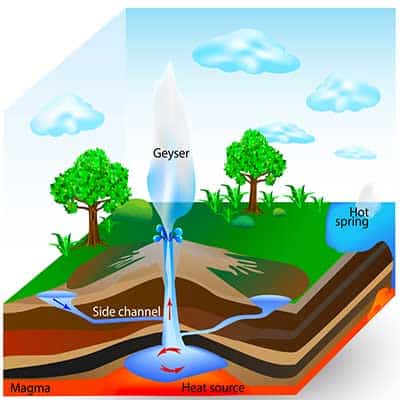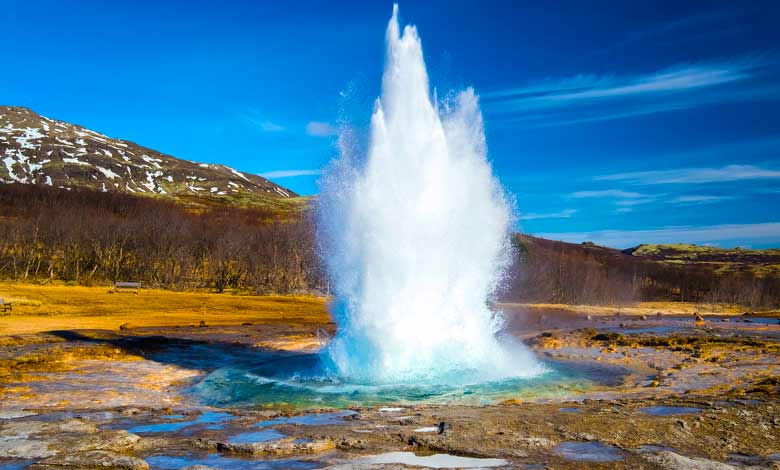Hey there, curious explorers and nature enthusiasts! Ever stood in awe at the sight of a geyser erupting, shooting steam and hot water into the air like Earth’s own spectacular fountain show? It’s a natural marvel that captures the imagination and begs the question: How does a geyser work? Well, you’re in for a treat because we’re going on a steamy journey beneath the Earth’s surface to uncover the mechanics behind these incredible natural phenomena.
Have you ever considered what would happen if you heated a kettle with no off switch with magma from the center of the earth? This is how geysers work. Yellowstone National Park in Wyoming, America, is a hotbed of thermal activity.
As much of the park sits in an ancient volcanic crater, it’s home to around 500 active geysers. Old Faithful is perhaps the most famous and was the first to be named in the park in 1870. It is so reliable, erupting every 91 minutes. It is said to be the most predictable geographical feature on Earth.
So, lace up your virtual hiking boots, and let’s trek into the geothermal wonders of our planet to learn about the science that powers geysers. Get ready—it’s going to be a hot topic!
How Does Geyser Work?
Geysers are natural geological features that erupt periodically, shooting hot water and steam into the air. Here’s a simplified explanation of how geysers work:
Underground Water Reservoir: Geysers are typically found in areas with volcanic activity, where underground water reservoirs are heated by geothermal energy. These reservoirs are usually in porous rock formations, such as fractured basalt or permeable sedimentary deposits.
Heat Source: The heat powers geysers from magma chambers deep beneath the Earth’s surface. The magma heats the surrounding rocks, including the water in the underground reservoirs.
Confining Pressure: The underground water reservoirs in geysers are typically confined by impermeable layers of rock or clay. This creates pressure within the reservoir, preventing the water from boiling even though it reaches temperatures above its boiling point.
Conduit System: Geysers have a complex network of narrow, vertical conduits that connect the underground water reservoir to the surface. These conduits allow the water and steam to rise to the geyser’s vent.
Superheated Water: As the water in the underground reservoir heats up, it becomes superheated—its temperature exceeds the boiling point without boiling due to the confining pressure. This superheated water is under significant tension and can erupt explosively when pressure is released.
Trigger Mechanism: A trigger mechanism is necessary to initiate a geyser eruption. This trigger can be a variety of factors, such as seismic activity, changes in groundwater levels, or a decrease in the confining pressure caused by a temporary blockage in the conduit system.
Eruption: When the trigger mechanism releases the pressure in the conduit system, the superheated water suddenly turns into steam, rapidly expanding and forcing the water column above it to shoot upward. This eruption can send hot water and steam tens of meters into the air.
Post-Eruption: After an eruption, the water in the underground reservoir begins to refill, and the cycle repeats as the reservoir is reheated by geothermal energy. The interval between eruptions varies for each geyser and can range from minutes to years.
A geyser is a spring that ejects water high into the air accompanied by a massive steam plume. Geysers need hydrogeological conditions to form, and only a handful of places on earth have such surroundings. Geysers are incredibly rare.
Structure of geyser
There are three vital ingredients to see geysers formed by millions of years of thermal activity and tectonic movement.
- Water
- Opening point/mouth.
- Heat

Water: Without water, it would simply be hot holes. The convoluted pathways through which the water has to move. Where does all that water in geyser eruption come from? Most Geysers are allocated near rivers or underground water sources. They draw their supply from these vital water tables. Others depend on rain and snowmelt, which filters four miles underground before it makes its way to the root of their source. But all that water is entirely useless. You have the correct plumbing.
Opening/Mouth: A geyser, known as the mouth, requires at least one opening on the Earth’s surface. Sometimes, this might be a single long vertical tunnel, while others are formed from a series of shafts. It runs for miles underground.
The system’s formation also requires a high concentration. It’s why light is an igneous volcanic glassy-like rock that contains minerals that line the keys as a plumbing system. This natural lining is vital because geysers operate under such extreme pressures. Miles underground, the ends of the tunnels eventually connect with the thermals rising from the earth’s center.
Heat: The final ingredient is heated. Scientists find geysers in areas of high volcanic and geothermal activity, and their water is heated by magma. That lies about five kilometers beneath the surface of the earth. While this might seem a long way down, it sits close to the Earth’s crust.
Geysers form on the edges of tectonic plates, constantly in motion. It’s this energy and movement which can create volcanoes and even earthquakes. Also, it makes the heat sources that geysers are needed to erupt.
Working process of geyser
An incredible eruption begins as water travels up the geyser tunnels. As these systems could be miles deep, the water at the very base of the tunnel becomes under incredible pressure from the water above it. As the magma at the base of the geysers tunnels warms the water from the bottom up, more and more energy builds in the system. Then the water begins to boil. When the pockets become turbulent, they push a small amount of water out of the geyser’s mouth, lowering the water’s pressure in the tunnels.
- A geyser needs a heat source of geothermal energy that comes from within the earth.
Geysers come in groups because they’re sitting at a high concentration of that energy. When water pools underground or collects in layers of porous stone near the magma’s surface, magma sits about three miles below that superheats. The pressures of the earth’s surface keep that water high above its boiling point. The balancing act comes in because of the heat and pressure.
- The geyser burst into steam with the sudden pressure change and heat drop within the water. The steam rapidly expands the volume of water by about 1,500 times.
As the water heats near the magma, a small amount will squirt from the surface, releasing that pressure. If the heat builds up too much, the boiling overwhelms the pressure of the rock, and then an eruption of steam happens. The expansion pushes the water and steam from its mouth and out as a violent eruption. The eruption will only stop when it runs out of water or cools down enough. After a while, the cycles start all over again.
Old Faithful gets its name because it erupts about every 45 to 110 minutes. It must have a constant level of heat and pressure under there so it keeps itself fairly balanced. It takes 50 years to erupt once.
From the intricate plumbing of underground water systems to the explosive release of steam and water, it’s clear that geysers are among Earth’s most fascinating and dynamic natural features. We hope this journey has heated your interest in geology and the powerful forces at work beneath our feet.
The world is full of wonders waiting to be understood and appreciated, so never stop exploring and asking questions about the incredible planet we live on. Thanks for joining us on this boiling exploration, and until next time, keep your curiosity bubbling and your spirit of adventure alive!
More Articles:
References:
Bryan, T. Scott. The geysers of Yellowstone. Niwot, Colorado: University Press of Colorado. ISBN 0-87081-365-X
Glennon, J.A., Pfaff, R.M. The extraordinary thermal activity of El Tatio Geyser Field, Antofagasta Region, Chile, Geyser Observation and Study Association (GOSA) Transactions, vol 8. pp. 31–78.
Glennon, J.A. About Geysers, University of California, Santa Barbara.
